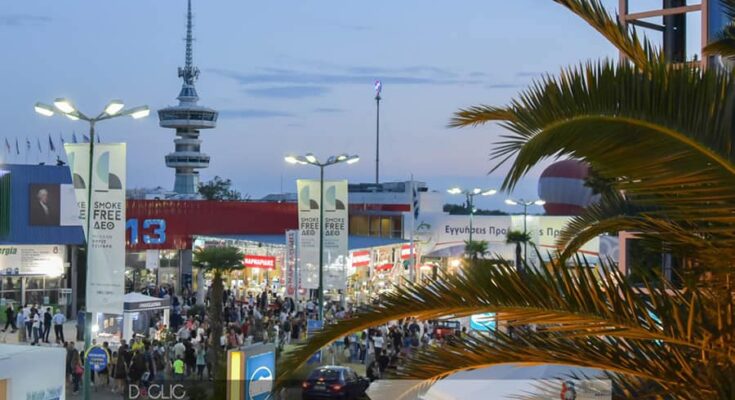
The Thessaloniki International Fair (TIF) is a commercial exhibition event of great importance in Greece and Southeastern Europe, taking place annually in Thessaloniki, Greece.
This year, the Thessaloniki International Exhibition Center will host the Fair which will be launched on Saturday. Thousands of visitors from Greece and across the world flock to Greece’s second city to be entertained, trade, browse, or simply be part of the festive atmosphere.
Germany is hosted as the honored country occupying more than 6,000 square meters of the exhibition space, where exhibits and services of leading domestic entrepreneurship companies will be presented.
Germany’s participation in the 88th TIF is seen as a great opportunity to strengthen and deepen Greek-German political, economic, and business relations.
27 foreign government institutions and companies will be represented at TIF, a significant increase compared to 18 in last year’s event.
The origins of the Thessaloniki International Fair

The original idea for the creation of an International Trade Fair was first expressed by Nikolaos Germanos, a Professor of Zoology at the Aristotle University of Thessaloniki and later a Member of the Greek Parliament.
In 1925, Sofoulis’ government decided to accept the idea, as they thought that an internationally oriented plan that would give Northern Greece and Thessaloniki a chance to attract the attention of the global markets was crucial.
The main motivation for going forward with the fair was due to the borders and the iron curtain of that era which deprived Thessaloniki of its natural mainland, the Balkans and Central Europe.
Sunday, October 3, 1926 was the day the first-ever TIF took place in an area of seven thousand square meters provided by the army.
The exhibition had six hundred participants of which 310 were from abroad. Two countries, Hungary and the Soviet Union, sent an official delegation to take part in the fair.
There were 150,000 people who visited the premises of the event, an astonishing number for the period. Over the years, the fair grew bigger and bigger, so a new place was needed to meet the demand.
In the mid-1930’s the decision for the transfer of the fair was reached. TIF, from the 1930s to modern day, was to take place in the center of the city, between Egnatia, Aggelaki, Tritis Septemvriou, and Leoforos Stratou streets—exactly where it takes place today.
The first TIF in the new area was in 1940, just a few weeks before the beginning of the Greek-Italian war. During the occupation of the city by the Nazis, the premises of the fair were confiscated, and there was a lot of destruction days before the departure of the German Army.
The first post-war fair, the 16th Thessaloniki International Fair, didn’t happen until 1951 during a period when Greece was finding its way after ten years of occupation and civil war.
The years ahead brought more and more visitors, rapid growth, and glory for Greece’s biggest trade event.
Milestones of the Thessaloniki International Fair
1926: Nicholas Germanos opened the doors of the first fair on October 3rd, which was housed at an army camp at the area of Stratigeio and covered 7,000 square meters. The first fair had six hundred participating exhibitors and attracted a total of one hundred thousand visitors.
1927: A year later, at the second TIF, which attracted two hundred thousand visitors, while everything was running normally on the afternoon of September 27th, the fair sunk into darkness due to a power outage.
1928: This was the first year that the Greek Prime Minister visited the TIF. Coming from Belgrade, Eleftherios Venizelos made a stop in Thessaloniki and the carpet exhibitors donated a rug to the Prime Minister.
1929: “Life Savers” company distributed free candies to its visitors. Due to the fact that Greeks had just come out of deprivation, the exhibition stand was full of parents who tried to purchase candy for their children.
1931: The Athens Electric Company presented the first electrical household appliances.
1935: The 10th International Fair was held without its founder for the first time, since Germanos had passed away in January of the same year.
1941: During the Nazi occupation, the Germans used the kiosks as warehouses and blew up the TIF buildings before they departed from the city. The exhibition, thereafter, remained closed for ten years.
1951: Prime Minister Nikolaos Plastiras announced the reopening of the TIF. Five billion drachmas were allocated for this purpose from the American Credit and another one billion for advertisement.
1954: The American pavilion presented the first closed circuit television, leaving guests speechless since it was the first time they could see themselves on screen.
1955: The TIF and the entire country was marked by the expulsion of Greeks from Constantinople. The Turkish pavilion in TIF closes before the end of the Fair.
1957: Dimitris Vakondios, an employee of the representative of the Nestlé company, created the first frappe coffee. Nestlé was introducing a new chocolate beverage for children that was produced instantly in a shaker.
During a break, Vakondios wanted to have his regular Nescafé Classic but could not find any hot water so mixed the coffee with cold water in a shaker.
1959: The USSR presented three model Sputnik satellites and the largest particle accelerator in the world.
1960: The idea of the International Film Festival, first launched by Linos Politis and Paul Zanna, was immediately adopted by the TIF.
1961: The Song Festival moves to Thessaloniki.
1963: There is a fire in the Patraiki booth due to short-circuit in electrical cables.
1964: Miss World Korina Tsopei, along with Miss USA Bobby Johnson, attract all visitors’ eyes at the premises of the TIF and actress Eleni Anousaki made such a sexy appearance that police tried to prevent her from entering the Film Festival’s administration building.
1970: The Tower of OTE was built. The architectural creation of Alexandros Anastasiadis became TIF’s trademark.
1971: On the opening day of the 36th TIF, the ferry Eleana was burned at the Adriatic Sea, leaving dozens dead.



